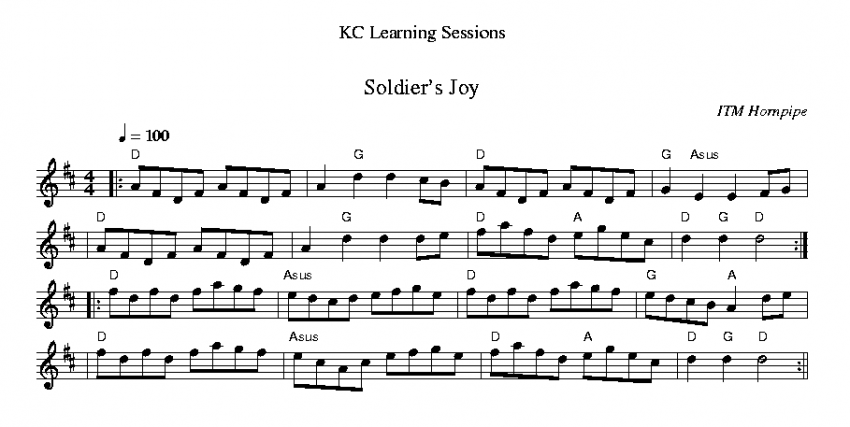At one time, probably around the 1760s, “Soldier’s Joy” was a very popular hornpipe in Ulster, and was often just called “The Clap Dance” because the dance involved turning and clapping hands with another person in the dance – which is fine when the dance is slow and everyone is sober, but can become problematic otherwise. It was first printed in Henry Beck’s Flute Book (1786), and by that time was popular on both sides of the Atlantic. It is now mostly played in sessions in Europe and in the States. In Norse-speaking countries it is called an “Engelska” (that is, an a dance tune from England), while in Estonia it’s called an “‘Ingliska” (that is, an a dance tune from England). In the States it has emigrated to Old-Time and Bluegrass sessions and, like people who do this, it has been somewhat changed in the process. If fact, if you search the U.S. Library of Congress “American Memory” webpage, you’ll find that it is also in Fiddle Tunes of the Old Frontier: The Henry Reed Collection, and read that the tune “is one of the oldest and most widely distributed tunes in the English-speaking world” (which I assume is including its variations). Though it’s a very popular Old-Time Fiddle tune, it is not particularly well-liked in Ireland anymore because (1) it’s either an English tune or a Scottish tune, but certainly not an Irish one, (2) it’s an old country-dance tune – what Aussie’s would call a “daggy tune,” (3) the melody is just too simple when played slow, and (4) it’s not a reel or a jig ;). Some people in Irish sessions will play it fast, and so make it into a reel, while others will play it slowly when someone else starts it, but will wag their heads back and forth mockingly as they play it. Not me though.
For the ABC click Soldier’s Joy
Soldier’s Joy, slow tempo

Soldier’s Joy
Like this:
Like Loading...
Related
Soldier’s Joy (D)
At one time, probably around the 1760s, “Soldier’s Joy” was a very popular hornpipe in Ulster, and was often just called “The Clap Dance” because the dance involved turning and clapping hands with another person in the dance – which is fine when the dance is slow and everyone is sober, but can become problematic otherwise. It was first printed in Henry Beck’s Flute Book (1786), and by that time was popular on both sides of the Atlantic. It is now mostly played in sessions in Europe and in the States. In Norse-speaking countries it is called an “Engelska” (that is, an a dance tune from England), while in Estonia it’s called an “‘Ingliska” (that is, an a dance tune from England). In the States it has emigrated to Old-Time and Bluegrass sessions and, like people who do this, it has been somewhat changed in the process. If fact, if you search the U.S. Library of Congress “American Memory” webpage, you’ll find that it is also in Fiddle Tunes of the Old Frontier: The Henry Reed Collection, and read that the tune “is one of the oldest and most widely distributed tunes in the English-speaking world” (which I assume is including its variations). Though it’s a very popular Old-Time Fiddle tune, it is not particularly well-liked in Ireland anymore because (1) it’s either an English tune or a Scottish tune, but certainly not an Irish one, (2) it’s an old country-dance tune – what Aussie’s would call a “daggy tune,” (3) the melody is just too simple when played slow, and (4) it’s not a reel or a jig ;). Some people in Irish sessions will play it fast, and so make it into a reel, while others will play it slowly when someone else starts it, but will wag their heads back and forth mockingly as they play it. Not me though.
For the ABC click Soldier’s Joy
Soldier’s Joy, slow tempo
Soldier’s Joy
Like this:
Related